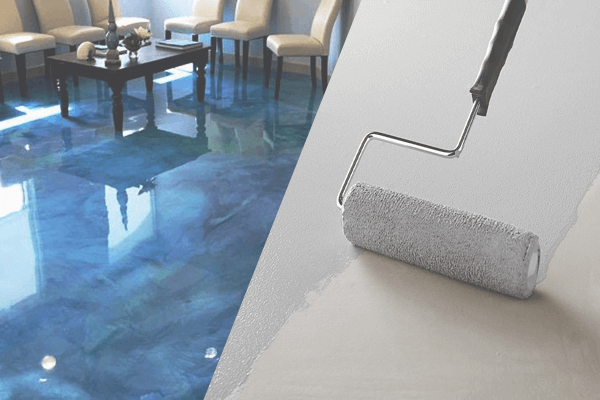Painting plays a vital role in transforming the overall look of buildings and making industrial equipment more durable and protective.
And in the world of paints, two types of paint are widely used. These are:
- Epoxy and
- Enamel
Before starting your next painting project, you must have a clear idea about the performance of these two types of paints as they show differences in functioning.
And in this article, we are going to discuss everything about epoxy vs enamel paint to help you determine the right type of paint that best suits your job.

Contents
Why Does It Matter To Know The Difference Between Epoxy And Enamel?
Applying a coat of paint does not mean only adding decorative color, it has other important uses and applications beyond enhancing total appearance.
As epoxy and enamel paint provide different functionality and performance, you should know the key things of these two types. By doing so, you can get your hands on the exact type of paint and become successful in achieving the desired result.
If you fail to choose the right type of paint according to your need, your hard-earned money and valuable time will get wasted.
For this reason, you must know the basics of epoxy and enamel paint.
And the next portion of this article will shed light on the topic.
Stay tuned!
Basics of Epoxy
Epoxy paint is made of latex acrylic with a small amount of epoxy to be added. It comes in a two-stage mix. That said the resin is mixed with the catalyst for hardening. And the hardened coating is resistant to chemicals, heat, and weather.
Epoxy paint offers more heavy-duty when compared to enamel paint and therefore, it is ideal for industrial and commercial usage. Since the paint is resistant to water, salt, and chemicals, it adds an additional layer of protection on the surface of steel and concrete.
In a word, you should apply epoxy paint in places that require resistance to higher corrosion and wear and tear.
Pros of Epoxy
Here are some advantages that epoxy paint has to offer:
- Protection: It offers an extra layer of protection from extreme temperature, corrosive fluids, and high impacts. If your working area is more rugged, especially in the processing plants, you should opt for epoxy paint without any second thought.
- Durability: Epoxy has extreme durability. It turns into a hard finishes surface after curing. So this application is guaranteed to outlast its competitors.
- Safety: Being a more hardened material, epoxy is fairly resistant to heat and fire.
- Weather withstanding: Epoxy can tolerate temperatures between 0 degrees to 140 degrees Fahrenheit. So you can choose it both for outdoor and indoor use.
- Finish: It has a chemically easy to clean and chemically resistant finish. And the ability to clean your processing plant is important.
- Versatility: You can use epoxy on a variety of surfaces, including metal, steel, concrete, and a variety of other materials.
Cons of Epoxy
Now let’s look at some cons:
- Strong application fumes: Wet epoxy emits an unpleasant odor during application. So you should ensure the availability of protective gears because the fumes can be toxic too along with the unpleasant scent.
- Time-consuming: Based on the type and intensity of the project, epoxy paint can take several days to cure completely. But smaller areas like garages could take 24 hours to cure.
Enamel Basics
Enamel paint is paint that is formulated for durability. Most of the time it is produced with Alkyd Resins which makes it easier on the equipment.
You can use it on surfaces like chairs, outdoor furniture, molding and trim, doors, etc. Enamel paint is effective for the areas that have a tendency to be bumped or kicked or where you need to have good washability.
Basically, there are two types of enamel paint: water-based and oil-based. Water-based paint is a lot easier to work with when compared to oil-based paint.
Enamel paint doesnt require any mixing. So it is truly a one-stage product and it comes ready to go.
Pros of Enamel
Here are some pros of enamel paint:
- Finish: You can get good finishes such as a semi-gloss, or gloss or even now with the acrylic formulation, you can get a very high gloss finish.
- Washable finishes: Enamel paint finishes are washable and easy to clean.
- Easy application: Enamel paint is easy to apply and it dries quickly when exposed to air. And the final appearance is almost perfect with little sheen. But oil-based paint comparatively requires a longer period. But it results in a harder finish.
- Color variation: Enamel paint comes in a wide variety of colors. So you don’t have to search here and there to find the right type of tones and shades.
- Extremely durable: Enamel paint has an impressive lifespan once hardened. As it offers resistance to stains and mildew, it can last for many years to come. The areas such as the living room, bedroom, kitchen, etc. that are prone to dirt and stain are ideal for enamel paint.
- No chemical reaction: Since enamel paint doesn’t require any mixing agent, there are no chemical reactions. All you need to do is just pop up the top, give it a little stir, and here you go.
Cons of Enamel
Now it is time to have a look at the cons. Here they are:
- Potentially toxic: Oil-based paint gives off strong odors that can be irritating, toxic, and harmful. But water-based paint is not harmful and does not emit any toxic fumes.
- Require repainting often: When exposed to heavy traffic and regular contacts of chemicals, enamel paint often requires repainting.
What You’ve Been Missing
How to Touch up Flat Wall Paint Like a Pro
Can you Caulk Between Baseboard and Floorboards
Final Thoughts
As you have to know the basics of epoxy vs enamel paint, you can now pick the exact type of paint.
Enamel paint is for general purpose application while epoxy paint is more ideal for industrial and commercial use.
And if you are still unsure about the type of paint, contact a professional to get the job done perfectly with having peace in your mind.
